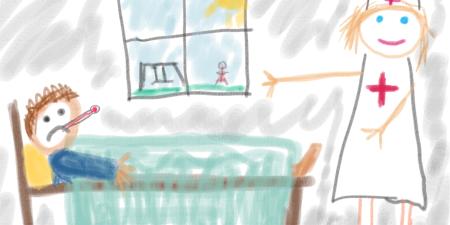Case
Sophie is a 7-month-old girl who was brought to the emergency department with symptoms that indicated increased intracranial pressure, including respiratory depression requiring intubation by paramedics during transit. A head CT revealed transtentorial herniation and large collections of blood, some of which appeared acute and some of which appeared chronic. There was also a nondisplaced occipital skull fracture. In the opinion of the chief of radiology, these were clear signs of nonaccidental trauma. An opthalmologist who detected multilayered retinal hemorrhages reached a similar conclusion.
Dr. Lopez, the attending physician in the PICU, assumed care after the patient was sent to the operating room, where a decompressive craniectomy was performed. The ED physician, Dr. Danner, contacted Dr. Lopez to let him know that, while they were still in the ED, Sophie’s mother and her boyfriend acted very strangely and the story they gave to explain Sophie’s condition did not match her injuries or the one they told Dr. Lopez. The police were called. They informed Sophie’s mother and her boyfriend that a full investigation would take place and the specific charges brought against them could change depending on Sophie’s ultimate outcome.
Now, 12 days later, Dr. Lopez has exhausted all of his medical and surgical therapies but Sophie continues to deteriorate. In a care conference with the family, Dr. Lopez and several colleagues encourage the family that withdrawing care is in Sophie’s best interest, but the family insists on pursuing aggressive continued treatment. Dr. Lopez is concerned that the family is making this decision out of self-interest, instead of considering what is best for Sophie, though he knows that he will have trouble confirming or contradicting those suspicions.
Commentary
Sophie’s case exemplifies the critical conflict in values and interests faced by numerous clinicians treating patients who lack the capacity to make their own medical decisions. Dr. Lopez and the medical team must weigh two competing ethical principles: (1) parental authority to make medical decisions and (2) Sophie’s best interest. Generally, a parent’s authority to make medical decisions on a child’s behalf does not compromise the child’s best interest. In some circumstances clinicians may become aware of evidence that a parent’s decisions are contrary to the patient’s best interest or that a secondary consequence—the threat of criminal charges, guilt, or numerous other factors—may be informing his or her motives. Families making end-of-life decisions for a child injured through suspected abuse may be influenced by the threat of criminal charges, feelings of guilt, and numerous other factors. Clinicians, with the support of ethicists and legal professionals, must ultimately determine who the appropriate decision maker is and whether the best interest of the child is being served, regardless of the parents’ motives.
Determining the appropriate decision maker for a child is different than appointing a surrogate for an adult patient. Clinicians generally presume that an adult patient is competent to make his or her own medical decisions, including whom to appoint as a surrogate. When an adult patient lacks capacity, the medical team may look to a surrogate appointed through an advance directives, or, when such a designation has not been made officially, statutes provide guidance about who the legal surrogate might be. In either case, surrogates for a patient who has previously been competent should be informed by the patient’s previously stated wishes or by evidence of his or her values. Children, however, have not yet had an opportunity to appoint a decision maker, identify their wishes, or establish evidence of their values. State and federal law and various professional committees have traditionally protected parental authority to make medical decisions for their children, including withdrawing or withholding life-sustaining treatment [1, 2]. But parents’ rights are not absolute and may be removed in limited circumstances, particularly when their actions place the child at risk of harm.
Parental authority relies on the presumption that parents will make decisions in the best interest of their child [3]. The “best interest” standard requires that the decision maker weigh the potential benefits and harms associated with a given decision. Scholars have debated what constitutes the best interest [3], but there is consensus that parents are usually best situated to determine it according to their family values. Evidence of a secondary gain or consequence complicates this assumption. Sophie’s family may be genuinely motivated by a belief that continuing life-sustaining treatments would be in Sophie’s best interest. However, the possibility that they are driven by the threat of criminal charges may seem to raise the question of whether the family can make a determination of Sophie’s best interest.
It is difficult to know when a parent’s decisions are contrary to the child’s interest or would result in harm. The process of determining the best interest of a critically ill child relies on the child’s medical status, prognosis, and the parent’s or family’s values. For children who are likely to survive and improve to normal function, the determination to continue with life-sustaining treatment is informed by the potential benefits of the treatment. Conversely, if a child is unlikely to survive or likely to suffer from severe neurological damage or continued severe burdens during life, the harms of continuing with painful treatment may outweigh potential benefit. Many cases fall between these two ends of the spectrum. The prognosis may be unclear or unknown.
Given differences in values and perceptions, clinicians and parents may disagree about what is in a child’s best interest. Here, the medical team seems to be of the opinion that withdrawing life-sustaining treatment would be in Sophie’s best interest given her declining medical status. However, it is unclear whether continuing treatment will cause Sophie harm (e.g., long-term pain or discomfort) and whether there remains any opportunity for Sophie to improve. Clinicians, with support from legal and ethics professionals, may make the determination that a parent’s decisions should not be respected only when the parent’s decisions are clearly contrary to the patient’s best interest.
If a parent is acting contrary to the best interest of the child, the medical team may seek judicial action. A state’s authority to overrule a parent’s rights stems from the doctrine of parens patriae. Under this doctrine, a state has the authority to protect the life and interests of individuals who are incapable of protecting themselves [3]. The American Academy of Pediatrics (AAP) recommends that a guardian ad litem be appointed “in all cases of child abuse requiring [life-sustaining medical treatment] in which a parent, guardian or prosecutor of the alleged abuser may have a conflict of interest” [4].
A guardian ad litem does not assume medical decision-making authority, but serves instead as an unbiased but compassionate advocate for the child’s best interests [5]. In most states, the guardian collects information about the child’s medical status, reviews law relevant to the circumstance, and makes a recommendation to the judge. Ultimately, a judge makes the final decision regarding withdrawal of life-sustaining treatment.
A majority of state courts have been reluctant to restrict parents’ constitutional rights by removing a parent’s decision-making authority. A determination that a parent’s rights should be restricted requires clear and convincing evidence that a given decision is contrary to the child’s best interest. This standard may be difficult to meet [2]. The AAP, too, supports a parent’s right to make decisions regarding withdrawing treatment, even in cases of suspected abuse [4]. It recommends that decisions regarding life-sustaining treatment for children injured by suspected abuse should be determined by the same standards used in making decisions regarding other critically ill children.
Under the standards discussed above, Dr. Lopez and the medical team must separate the decision-making process from the cause of the potential injury and look only at whether continuing life-sustaining treatment is contrary to Sophie’s best interest. Given Dr. Lopez’s determination that he has exhausted all medical options, the team must then consider the burden to Sophie of continued support. They may be obligated to pursue discontinuing support if they conclude that continued treatment is not beneficial and would harm Sophie. These obligations stem from professional duties of beneficence and nonmaleficence.
A decision to discontinue life-sustaining treatment against the family’s wishes will require the medical team to consult their ethics and legal advisors about removing Sophie’s mother’s parental authority through judicial intervention. Importantly, in cases when external factors such as known or suspected nonaccidental injury weigh heavily on clinicians’ perceptions, they should not lose focus on the patient’s best interest. Dr. Lopez and the medical team should make decisions based on Sophie’s best interest, not according to the secondary consequences for the family or the suspected cause of her injuries.
References
-
American Academy of Pediatrics Committee on Bioethics: guidelines on foregoing life-sustaining medical treatment. Pediatrics. 1994;93(3):532-536.
- Ellingson CC, Livingtson JS, Faranoff JM. End-of-life decisions in abusive head trauma. Pediatrics. 2012;129(3):541-547.
- Diekema DS. Parental refusals of medical treatment: the harm principle as threshold for state intervention. Theor Med Bioeth. 2004;25(4):243-264.
-
American Academy of Pediatrics. Committee on Child Abuse and Neglect and Committee on Bioethics. Foregoing life-sustaining medical treatment in abused children. Pediatrics. 2000;106(5):1151.
-
Gladsjo JA, Breding J, Sine D, et al. Termination of life support after severe child abuse: the role of a guardian ad litem. Pediatrics. 2004;113(2):e141.



